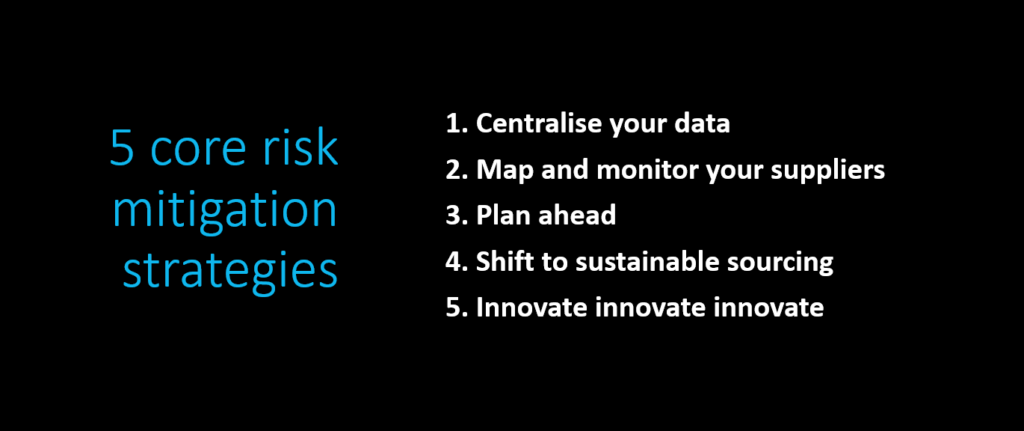- Articles
Risk management in procurement – Why is it so critical and what does it mean for today’s CPO?

In times of crisis, outrunning risk means having a smart procurement system in place – and in today’s market, smart means digital. When global supply chains break down, procurement professionals with strong digital strategies are well-positioned for rapid reconfiguration while the rest are left asking themselves how they can be better prepared next time.
In December last year, an online survey by Procurement Insights polled procurement professionals on what they saw as their most significant risk for 2020. The answer wasn’t what you might think.
The biggest perceived risk wasn’t from external threats like pandemics, cyber-attacks, or economic downturns – although we see from the Corona virus unfolding that these are all legitimate concerns. Instead, the top risk by quite a large margin was to do with digital procurement strategy, or more specifically, the risk of not having one. This perception of risk among respondents was presumably based on the fear that in the event of a global disaster they would not have the agility and speed to rally the right response.
“When big global crises hit, if you’re a CPO and your digital house is not in order, manual reconfiguration of your sourcing strategy will be particularly difficult,” warns Joonas Jantunen, Cloudia’s CEO for Middle East and Africa, “especially if your team and your suppliers are spread out across different geographies.”
What does digitalisation have to do with risk?
First, from the point of view of ‘business as usual’ risk, Jantunen believes the case has already been well made for digital transformation of procurement to bring a new level of competitive advantage to organisations. “In some sectors, you could even argue that going digital has become a licence to operate,” Jantunen says.

But digitalisation on its own is not the magic bullet for eliminating risk. The rise of digitalisation in procurement as a risk management strategy has been driven by the changing role of procurement and the CPO in business overall.
During the years since the global financial crisis in 2008, with margins shrinking amid financial uncertainty, the CPO’s capacity as a ‘cost killer and a ‘revenue generator’ at the frontlines has emerged strongly. Enlightened business leaders are coming to understand that procurement is no longer just about ordering goods and processing transactions, but can converge with other business areas including Finance, IT, HR, supply-chain management and not least risk management, to become a more strategic-level business function.
With the right digital tool box, a CPO can have a clear line of sight all the way from the executive suite to the outermost reaches of the supply chain, and using the power of this macro vantage point, is well-positioned to assess how an organisation’s supplier locations and activities are directly impacting profitability, or, posing a potential risk to business continuity.
But success is about more than just going digital
Success in mitigating risk for CPOs still hinges heavily on how well this broader role is recognized across an organisation’s key decision makers. Success will also depend on digital connectivity and how well procurement systems are integrated with other critical systems such as ERP and CRM across the business. Only with connectivity can your data be fully put to work, enhancing your planning and efficiency through improved data visibility, monitoring and driving procurement and supplier performance, as well as analysing current risk and predicting future risk scenarios.
“Managing risk effectively from a procurement and supply-chain perspective, means knowing your business back to front and inside out,” Jantunen stresses. “And even though you can’t influence the many external factors being thrown at you, with digital procurement there is a great deal you can do to mitigate risk related to your supply chain.”

Five core risk mitigation strategies:
1 Centralise your sourcing and contract data
Even in times of crisis, all a procurement team will need to fully function is Wi-Fi and a few working devices. You don’t need hardware. You don’t need files or spreadsheets or dusty paper contracts that have been passed hand to hand around the office. Nor do you need to find the guy who left the company last month, to tell you which cabinet he stored last year’s contracts.
But even without disaster, once you go digital, you can centralise your sourcing and contract management functions very easily into one digital hub, with the potential to bring large economies of scale and a higher level of cooperation. Procurement teams in different geographical locations, will all have real-time access to the same relevant data, including cost structures, supply availability, lead times, financial and operational risks, as well as service and quality metrics all of which can be put to good everyday use across the organisation in maximizing profitability, minimizing spend, and eliminating any potentially costly errors.
You can also automate your periodic contract monitoring with alerts, tracking tasks related to different contract phases, with all the latest contract information, including price attachments, also available in real time.
2 Map and monitor your suppliers
Once you’ve centralised your data source, it’s important to create a clear digital map of your upstream suppliers. At the same time, look at the geographical spread of your supplier network. Do you have too many concentrated in one area?
“Just knowing the first-tier is not enough,” Jantunen advises. “Go back as many tiers as you can.” Having a clear supplier map in advance of a global crisis, will make you nimbler at the outset in just understanding the initial impacts of a crisis. “Without knowing where your second or third tier suppliers are located,” says Jantunen, “you’ll be playing catch up when it comes to reconfiguring your suppliers to restore continuity.”
But even before crises hit, the increased transparency in supplier monitoring and follow-up that digital systems provide can position procurement teams to detect early behavior changes or potential risks related to product supply shortages or service disruptions and prepare for them in time.
3 Plan ahead
That brings us to another key risk mitigation strategy – planning ahead. Good advanced planners should always be asking themselves: What is the market doing? Are we up to date? Do we have the right people and systems in place? Then continuously apply that knowledge to alleviate risk.
Digital procurement promotes systematic advanced planning and scheduling. This can be done by adding specificity to your requests for proposals. For example, you can tackle geographical risks by setting the selection criteria in your digital sourcing tool for various global locations, while still attracting the highest quality candidates. You can also prepare for logistical threats by considering alternative transport models and possibly the establishment of interim storage facilities, even on different continents, to ensure that, at least in the short term, supply problems do not arise, making it possible to respond more quickly to customer needs.
Supply chains can also be designed in advance to help you rapidly reconfigure in times of crisis or sudden disruptions. This could involve setting up backup capacity in the form of a secondary sourcing chain that operates outside your primary sourcing area. Alternatively, you could design your network to be able to source locally when needed. That means having local production and supply capacity established in all areas where you operate.
“In both these examples by lowering risk you may, however, face higher administrative costs related to monitoring and allocating supply to a secondary source,” says Jantunen.
“But configuring your supply chain is not a one-time exercise. In good times and bad, CPOs can continually be planning ahead and looking for new ways to balance risk versus future business competitiveness.”
“Remember it only takes one component supplier with a poor social or environmental policy to seriously disrupt your organisation’s supply chain as well as damage your own brand reputation.”
4 Shift to sustainable sourcing
As part of this process, procurement leaders should not underestimate the growing importance of sustainability in sourcing. A full sustainability review of your global supply chain that takes into account the overall cost of doing business in terms of people, planet and profits can mitigate risk, making you more resilient to supply shortages or production breaks related to environmental or social upheavals within your supply-chain.
“Remember it only takes one component supplier with a poor social or environmental policy to seriously disrupt your organisation’s supply chain as well as damage your own brand reputation,” warns Jantunen.
Embedding the triple bottom line into your sourcing requirements can also significantly enhance your brand, and could include setting up environmental impact targets such as CO2 reduction goals, stipulating locally sourced goods, requiring lean transportation times and delivery routes, or the use of low-carbon green fuels and green packaging. In public sector or socially-driven enterprises, strategic sourcing can also be in support of strategies for a more inclusive society in areas like diversity, gender and other equitable business practices.
5 Innovate innovate innovate
In times of crisis, a digital system is the means for CPOs and their teams to quickly restore some level of business clarity, which can in turn create space to rethink and reconfigure, and even open the way for surprise innovations.
At the beginning of the corona outbreak, automakers in the US and Europe started working with GE Healthcare and 3M to design ventilators that could be produced using fans, batteries and other parts that are typically shipped for cars. Elsewhere whisky distillers began switching to hand sanitizer, and in Italy and some Nordic countries, there were stories of hospitals running short of respiratory valves turning to local 3D printing companies for supplies.
But companies don’t need to wait for a global crisis to innovate. Innovation can come from anywhere, at any time. In many cases, innovation can come from your suppliers. Engaging more deeply with your top tier suppliers is one approach that allows CPOs to innovate while managing and sharing risk. This can come through creating buyer-supplier programs with the aim of sharing business critical details that go beyond the traditional buy-sell approach.
“This willingness to share opens you and your suppliers up to joint brainstorming on your processes and products that can truly transform the risk landscape for both parties as well as create new value.”
It’s impossible to anticipate the arrival of global crises, but with a strong digital strategy in place, procurement functions can mitigate their impacts by taking supply-chain preparedness to a whole new level, and with CPOs playing an outsized role in protecting their organisations and restoring business continuity.
Read also what makes a CPO great in times of crisis and how a procurement team can operate efficiently and responsibly during exceptional situations.


